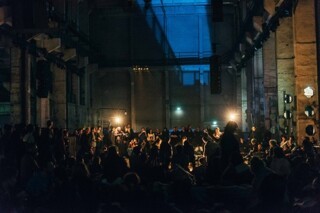At the Slaughterhouses
Adam Shatz
On my first visit to Algiers, in 2002, I met a friend for dinner in the abattoir neighbourhood. The city's great slaughterhouses are among the oldest in North Africa. ‘There is nothing like the meat in the abattoirs,’ my friend insisted. We ate skewers of grilled lambs’ kidneys: rich, salty, succulent cubes of meat served with nothing but baguettes to wrap them in.
The abattoirs are now the site of a future ruin, slated for destruction to make way for a new national assembly. In 2013, a group of artists circulated a petition calling on the government to turn them into an arts centre that would preserve their memory as part of Algeria’s cultural heritage. Hassen Ferhani, a young filmmaker, spent two months inside a slaughterhouse. The result is an oddly beautiful film, Dans ma tête un rond-point (‘A Roundabout in My Head’), which Ferhani presented last week at the Anthology Film Archives in New York City.
Abattoirs, like prisons and hospitals, have a dark poetry that has long fascinated artists and writers. It inspired some of the most vivid passages in A Seventh Man, John Berger's 1975 book with the photographer Jean Mohr on migrant workers:
Then both the men, bent over the animal together, would dress and skin and eviscerate it, talking while they did so or working silently and taking a pride in their deftness with the knife. In the winter when it was cold, the carcass gave off a warmth … In the full summer heat blood smells different – producing a kind of urgency through a fear of nausea: a fear so improbable that is the more striking.
Ferhani's film isn’t the first to be set in a slaughterhouse, or even the first documentary about a slaughterhouse in the Arab world. In Beirut in 2002, I went to the première of Jalal Toufic's The Sleep of Reason: This Blood Spilled in My Veins, an unbearably explicit depiction of a cow being killed. 'The organic dying' of a person, Toufic said in his programme notes, 'is as nothing compared to that of an animal’.
Dans ma tête un rond-point, however, is not about dying, but about living in a post-colonial country where the fruits of liberation are, for most people, a distant memory at best. There’s a fair amount of blood, all the same. In one blackly comic scene, a group of workers struggle to pull a very stubborn cow by a rope, just as the Algerian football team scores a goal at the World Cup. But the killing mostly takes place off-stage, leaving Ferhani to explore the experiences of the abattoir workers, for whom the slaughterhouse is not only a place of employment, but where they live. The men he interviewed are migrant labourers from rural Algeria. They send meagre remittances to their families, whom they see only a few times a year. Some dream of return to the bled (the countryside); others of escape to Europe.
Ferhani told his subjects that they could talk to him about anything except meat. Two young men – one in the throes of first love, the other styling himself as a kind of relationship counsellor – discuss the rules of attraction and courtship rituals. (There are no women in the film; the only women who work at the abattoir are its two vets, and they don't mix much with the men.) A group of men sit around a table debating why Zinedine Zidane plays for France, not Algeria (the answer, money, isn't surprising, but it's funny to see them knock Zidane off his pedestal). An old man sits outside the slaughterhouse, talking to anyone who will listen about the three monotheistic faiths. A depressed young man, Yusuf, says that in Algeria there are only four choices for a young person: 'filling your head with bad things’, becoming a criminal, crossing to Europe by boat or committing suicide. Yusuf isn't persuaded when a fellow worker suggests the path of revolution. Even if the Arabs and Berbers united in revolt, he says, Algeria would end up worse off, like Egypt.
Amu – middle-aged, grizzled, handsome – was one of the few workers who didn't want to talk on camera straight away. For the first few weeks of filming he kept to himself. But Ferhani waited for him, and his patience was rewarded. Amu tells a magical, perhaps apocryphal story about a French army unit who surrounded a village during the War of Independence to hunt for a stork. ‘Their eyes were everywhere, like wolves,’ he says. He seems amused by Ferhani's project, and answers him in parables and aphorisms. His favourite line – he repeats it throughout the film – is that he doesn't tell lies, but he doesn't stumble on the truth, either. Perhaps, he suggests, that should be the title of Ferhani's film. (He was disappointed that it isn't, Ferhani says.)
Ferhani screened his film at a festival in Algiers, but the workers didn't show up – they don't often leave the factory. So he went to them. Watching Dans ma tête un rond-point, I was reminded of the film collectives of the 1970s – Chris Marker's Medvedkine Group, and Jean-Luc Godard and Jean-Pierre Gorin's Dziga Vertov Group, most notably – that used factories to examine the struggles and contradictions in their societies. Ferhani's film, though not politically militant, shares their commitment to recording the voices and subjectivity of workers, without pity or contempt. It also shares their formal rigour: the film never leaves the abbatoir. We are looking at a world soon to vanish. Meat may be murder, but Ferhani shows that it has also been a way of life, and few films have captured so intensely the peculiar fragrance of the abattoir.

Comments